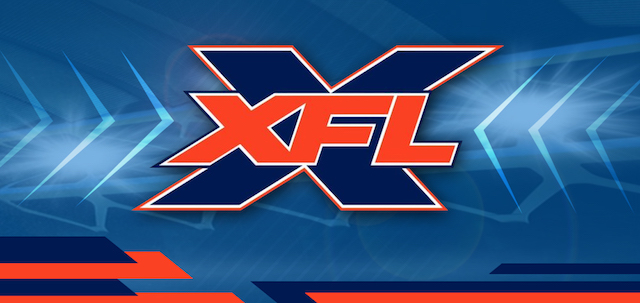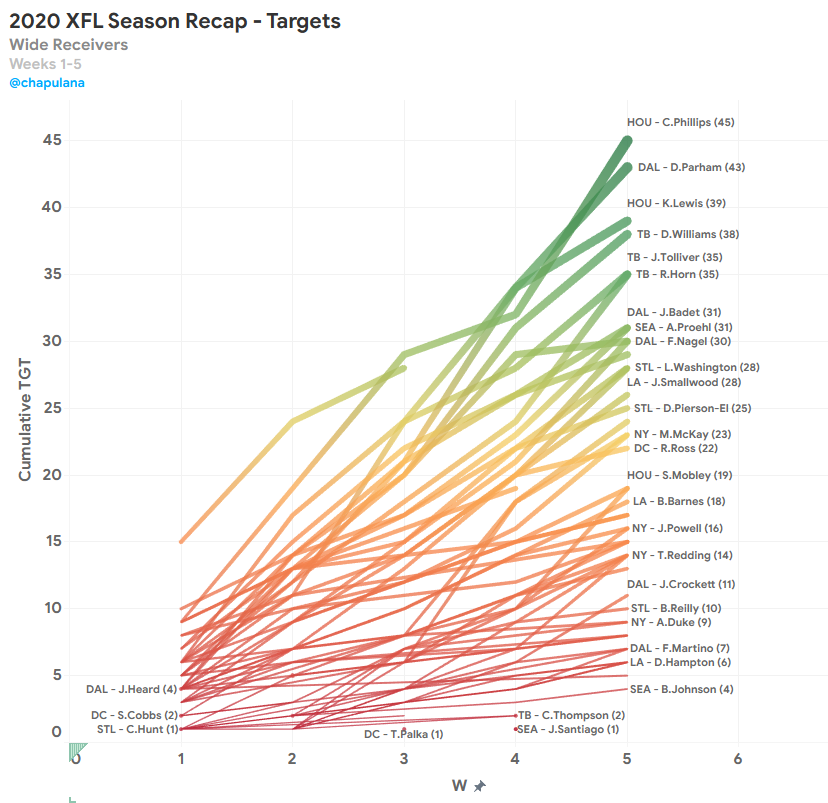
Antonio Losada evaluates wide receivers and tight ends at the end of the XFL's 2020 season to determine which teams produced the most value at the positions.
This column is a continuation of the weekly Risers/Fallers series that ran during the XFL 2020 regular season. The twist is that I'll cover the full (half) season instead of a week's worth of games.
If you missed the running backs report, you can check it out right here.
Now, let's look at XFL receivers (wide receivers and tight ends) on the whole and how they performed in terms of their receiving stats. Let's get to it!
Featured Promo: Get any Props Premium Pass for 30% off using code NEW. Win more with our two new Props Optimizer tools -- one for PrizePicks Props, and one for Sportsbook Betting Props. Find optimal prop bets and get our recommended picks daily! Go Premium, Win More!
XFL Season Recap: Targets
Five weeks, that's all we got. Not many games, but enough to have a sizable data set to crunch and extract some interesting takeaways. If something defines a receiver, that is volume and how much a team relies on his talent to rack up yards and ultimately score touchdowns. There have been three teams that have made use of multiple receivers on a heavy basis during this season, while others have focused on just one target during most of the year.
This is how individual players have done in terms of cumulative targets.
Houston's Cam Phillips finished the season as the most-targeted player in the XFL, barely edging Dallas' tight end Donald Parham. Both of them maintained their week-to-week targets mostly up (though Phillips were virtually shut down in Week 4) steadily, and became two of the most reliable receivers in the game.
That line at the top left represents Nelson Spruce, who was in contention for the lead entering Week 4 but didn't take part in that game or Week 5 either with his season ending just after Week 3. Expect a nice comeback from Spruce next season, as he was one of the best players on the field during the time he spent on it.
In terms of teams and their player usage, you can see at the top of the leaderboard how two of the top three players were on Houston, while three of the top six and three of the top nine were part of the Tampa Bay Vipers and Dallas Renegades respectively. On the other hand, Seattle and DC relied mostly on one lone receiver, Austin Proehl in the case of the former and Eli Rogers for the latter Defenders.
XFL Season Recap: Receptions
When it came to catching the ball, up to 18 players finished the year with at least 15 receptions, averaging three or more per game each. The cream of the crop was formed by four receivers reaching and beating the 25-reception mark, while a grand total of 64 receivers logged at least one reception on the first XFL season. Although the difference in targets and receptions wasn't very large between players, that wasn't the case in actual receiving yards as we'll see later.
This is how individual players have done in terms of cumulative receptions.
The story this chart tells is pretty much that of the one representing the targets. There are a few changes here and there, but the most targeted players were mostly those with a high number of receptions too, which makes all of the sense in the world.
Cam Phillips, unsurprisingly, beat the competition by a healthy margin compared to the rest of the field finishing the year with four more receptions than second-ranked Reece Horn (the same difference as that between Horn and no. 6 Dan Williams and De'Mornay Pierson-El). It isn't surprising either to find two Roughnecks (Phillips and Kahlil Lewis), two Vipers (Horn and Williams) and two Renegades (Flynn Nagel and Parham) in the top-six of those with the most receptions given the heavy usage they experienced.
Of those logging at least 20 targets (20 players did), here is how they finished the season in terms of catch rate.
 As you see, Cam Phillips drops all the way to 14th in the Catch% leaderboard with a 62.9% catch rate, though it must be said he was the most targeted receiver. Kahlil Lewis was the best of those heavily targeted (35+ targets) with a Catch% of 67.9, while De'Mornay Pierson-El was automatic at catching the rock finishing the year with a rather impressive 91.3% catch rate and being the only player inside the 90s.
As you see, Cam Phillips drops all the way to 14th in the Catch% leaderboard with a 62.9% catch rate, though it must be said he was the most targeted receiver. Kahlil Lewis was the best of those heavily targeted (35+ targets) with a Catch% of 67.9, while De'Mornay Pierson-El was automatic at catching the rock finishing the year with a rather impressive 91.3% catch rate and being the only player inside the 90s.
XFL Season Recap: Receiving Yards
I warned you in the section above: huge things were coming. Ask Cam Phillips. Not only did Phillips led the targets and receptions leaderboards, but he also completely dominated the yardage one - not by a low amount either. Phillips became the premier receiver of the whole XFL and produced 67 more yards than second-best Dan Williams. In fact, Phillips' 455 yards were over 17% more than Williams' 338, which is an insane level of production.
The league-average receiver (averaging the 68 final-season tallies) averaged 108.3 yards on the season; removing Phillips from that 68-player group would drop that average five yards to 103.1 on the season, and Phillips' 455 yards would be 441% as many as those 103.1 of the average receiver, making him almost 4.5 times more valuable!
This is how individual players have done in terms of cumulative yardage.
I have already told you about Cam Phillips' exploits. Now, take a look at the chart and imagine how things could have ended had Phillips not been double- and triple-teamed back in Week 4 when he was virtually shut down and could only add nine yards to his season tally. We might be talking about a 550-yard season in just five weeks of playing time!
Although Pierson-El had the best Catch% rate of any receiver, he could only rack up the 15th-most yardage on the year (209 yards) making him a safe option to throw to but with limited upside.
That is why Pierson-El shows down-and-mid in the chart above. In terms of yards per catch and reception, Nelson Spruce and Tre McBride (although both in smaller samples of just three games) clearly beat the rest of the league receivers, while Rashad Ross did so in a full five-game season though racking up under 200 yards total.
XFL Season Recap: Receiving Touchdowns
Not a lot to explain here. Sure, touchdowns are volatile, unpredictable, and more random than any other stat in football. But when you have someone like Cam Phillips in your team (and P.J. Walker as the quarterback, not trying to take anything from him), you know what you're in for.
Phillips more than doubled the total touchdown tally of the two second-best receivers at it Donald Parham and Tre McBride. And with that, Phillips led every single counting stat category at his position. The only thing he lacked was to convert a single extra point (no matter its value) and, well... to commit a fumble on the season.
Although nothing impressive on a pure raw-stat counting, Saeed Blacknall's two touchdowns on just four receptions went for the best TD-rate of the year, while he was also able to rack up a monster 120 yards in those four catches--he was a butter-hands player, though, with just 4-for-14 receptions.
More XFL Coverage
 RADIO
RADIO






























